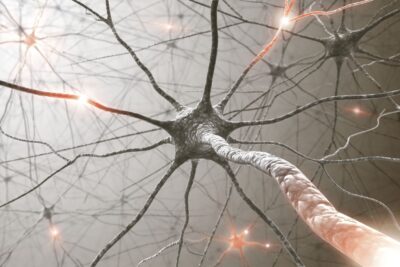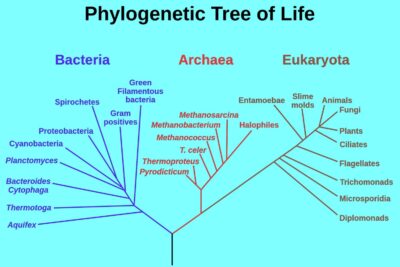
Mutualism describes a type of mutually beneficial relationship between organisms of different species. It is a symbiotic relationship in which two different species interact with and in some cases, totally rely on one another for survival. Other types of symbiotic relationships include parasitism (where one species benefits and the other is harmed) and commensalism (where one species benefits without harming or helping the other).
Organisms live in mutualistic relationships for a number of important reasons, including a need for shelter, protection, and nutrition, as well as for reproductive purposes.
Lectura relacionada:
 Las diferencias entre ARNip y miARN
Las diferencias entre ARNip y miARNTypes of Mutualism
These ocellaris clownfish are hiding in an anemone. Clownfish and anemones live together in a mutualistic symbiotic relationship. They protect each other from predators.
Photograph by Mikael Kvist/ Moment/Getty Images
Mutualistic relationships can be categorized as either obligate or facultative. In obligate mutualism, the survival of one or both organisms involved is dependent upon the relationship. In facultative mutualism, both organisms benefit from but are not dependent upon their relationship for survival.
A number of examples of mutualism can be observed between a variety of organisms (bacteria, fungi, algae, plants, and animals) in various biomes. Common mutualistic associations occur between organisms in which one organism obtains nutrition, while the other receives some type of service. Other mutualistic relationships are multifaceted and include a combination of several benefits for both species. Still others involve one species living within another species. Following are some examples of mutualistic relationships.
Lectura relacionada:
 Cuatro Tipos de Estructura Proteica
Cuatro Tipos de Estructura ProteicaPlant Pollinators and Plants
This bee has pollen attached to its body as it is seeking to get nectar from the flower.
Tobias Raddau/EyeEm/Getty Images
Insects and animals play a vital role in the pollination of flowering plants. While the plant-pollinator receives nectar or fruit from the plant, it also collects and transfers pollen in the process.
Flowering plants rely heavily on insects and other animals for pollination. Bees and other insects are lured to plants by the sweet aromas secreted from their flowers. When the insects collect nectar, they become covered in pollen. As the insects travel from plant to plant, they deposit the pollen from one plant to another. Other animals also participate in a symbiotic relationship with plants. Birds and mammals eat fruit and distribute the seeds to other locations where the seeds can germinate.
Lectura relacionada:
 Prefijos y Sufijos de Biología: - ase
Prefijos y Sufijos de Biología: - aseAnts and Aphids
An argentine ant is farming aphids on a young leaf. The ants feed on honeydew and the aphids receive protection from the ants.
George D. Lepp/Corbis Documentary/Getty Images
Some ant species herd aphids in order to have a constant supply of honeydew that the aphids produce. In exchange, the aphids are protected by the ants from other insect predators.
Some ant species farm aphids and other insects that feed on sap. The ants herd the aphids along the plant, protecting them from potential predators and moving them to prime locations for acquiring sap. The ants then stimulate the aphids to produce honeydew droplets by stroking them with their antennae. In this symbiotic relationship, the ants are provided with a constant food source, while the aphids receive protection and shelter.
Oxpeckers and Grazing Animals
A red-billed Oxpecker (Buphagus erythrorhynchus) feeds on parasites from the ear of an Impala (Aepyceros melampus) in Moremi Game Reserve, Chobe National Park.
Ben Cranke/The Image Bank/Getty Images
Oxpeckers are birds that eat ticks, flies, and other insects from cattle and other grazing mammals. The oxpecker receives nourishment, and the animal that it grooms receives pest control.
Oxpeckers are birds that are commonly found on the sub-Saharan African savanna. They can often be seen sitting on buffalo, giraffes, impalas, and other large mammals. They feed on insects that are commonly found on these grazing animals. Removing ticks, fleas, lice, and other bugs is a valuable service, as these insects can cause infection and disease. In addition to parasite and pest removal, oxpeckers will also alert the herd to the presence of predators by giving a loud warning call. This defense mechanism provides protection for the oxpecker and the grazing animals.
Clownfish and Sea anemones
This clownfish is seeking protection within the tentacles of the sea anemone. Both of these organisms protect the other from potential predators.
tunart/E+/Getty Images
Clownfish live within the protective tentacles of the sea anemone. In return, the sea anemone receives cleaning and protection.
Clownfish and sea anemones have a mutualistic relationship in which each party provides valuable services for the other. Sea anemones are attached to rocks in their aquatic habitats and catch prey by stunning them with their poisonous tentacles. Clownfish are immune to the anemone's poison and actually live within its tentacles. Clownfish clean the anemone's tentacles keeping them free from parasites. They also act as bait by luring fish and other prey within striking distance of the anemone. The sea anemone provides protection for the clownfish, as potential predators stay away from its stinging tentacles.
This lemon shark has remora fish attached to its body. The two have a mutualistic symbiotic relationship.
Cat Gennaro/Moment/Getty Images
Remora are small fish that can attach to sharks and other large marine animals. Remora receive food, while the shark receives grooming.
Measuring between 1 to 3 feet in length, remora fish use their specialized front dorsal fins to attach to passing marine animals, like sharks and whales. Remora provide a beneficial service for the shark as they keep its skin clean of parasites. Sharks even allow these fish to enter their mouths to clean debris from their teeth. Remora also consume unwanted scraps left over from the shark's meal, which helps to keep the shark's immediate environment clean. This reduces the shark's exposure to bacteria and other disease-causing germs. In exchange, the remora fish get free meals and protection from the shark. Since sharks also provide transportation for remora, the fish are able to conserve energy as an additional benefit.
Lichens
A lichen is a symbiotic association of an alga and a fungus--mutualism. This species is very common and grows on bark of all kinds of trees in partial shade or sun. Lichens are sensitive to atmospheric pollution.
Ed Reschke /Oxford Scientific/Getty Images
Lichens result from the symbiotic union between fungi and algae or fungi and cyanobacteria. The fungus receives nutrients obtained from the photosynthetic algae or bacteria, while the algae or bacteria receive food, protection, and stability from the fungus.
Lichens are complex organisms that result from the symbiotic union between fungi and algae or between fungi and cyanobacteria. The fungus is the major partner in this mutualistic relationship that allows lichens to survive in a number of different biomes. Lichens can be found in extreme environments like deserts or tundra and they grow on rocks, trees, and exposed soil. The fungus provides a safe protective environment within the lichen tissue for the algae and/or cyanobacteria to grow. The algae or cyanobacteria partner is capable of photosynthesis and provides nutrients for the fungus.
Nitrogen-Fixing Bacteria and Legumes
Symbiotic root nodules on alfalfa containing nitrogen-fixing Rhizobium bacteria.
Inga Spence / Photolibrary/Getty Images
Nitrogen-fixing bacteria live in the root hairs of legume plants where they convert nitrogen to ammonia. The plant uses the ammonia for growth and development, while the bacteria receive nutrients and a suitable place to grow.
Some mutualistic symbiotic relationships involve one species living within another. This is the case with legumes (such as beans, lentils, and peas) and some types of nitrogen-fixing bacteria. Atmospheric nitrogen is an important gas that must be changed into a usable form in order to be utilized by plants and animals. This process of converting nitrogen to ammonia is called nitrogen fixation and is vital to the cycle of nitrogen in the environment.
Rhizobia bacteria are capable of nitrogen fixation and live within the root nodules (small growths) of legumes. The bacteria produce ammonia, which is absorbed by the plant and used to produce amino acids, nucleic acids, proteins, and other biological molecules necessary for growth and survival. The plant provides a safe environment and adequate nutrients for the bacteria to grow.
Humans and Bacteria
Bacteria live in the intestines and on the body of humans and other mammals. The bacteria receive nutrients and housing, while their hosts receive digestive benefits and protection against pathogenic microbes.
A mutualistic relationship exists between humans and microbes, such as yeast and bacteria. Billions of bacteria live on your skin in either commensalistic (beneficial to the bacteria but do not help or harm the host) or mutualistic relationships. Bacteria in mutualistic symbiosis with humans provide protection against other pathogenic bacteria by preventing harmful bacteria from colonizing on the skin. In return, the bacteria receive nutrients and a place to live.
Some bacteria that reside within the human digestive system also live in mutualistic symbiosis with humans. These bacteria aid in the digestion of organic compounds that otherwise would not be digested. They also produce vitamins and hormone-like compounds. In addition to digestion, these bacteria are important to the development of a healthy immune system. The bacteria benefit from the partnership by having access to nutrients and a safe place to grow.












